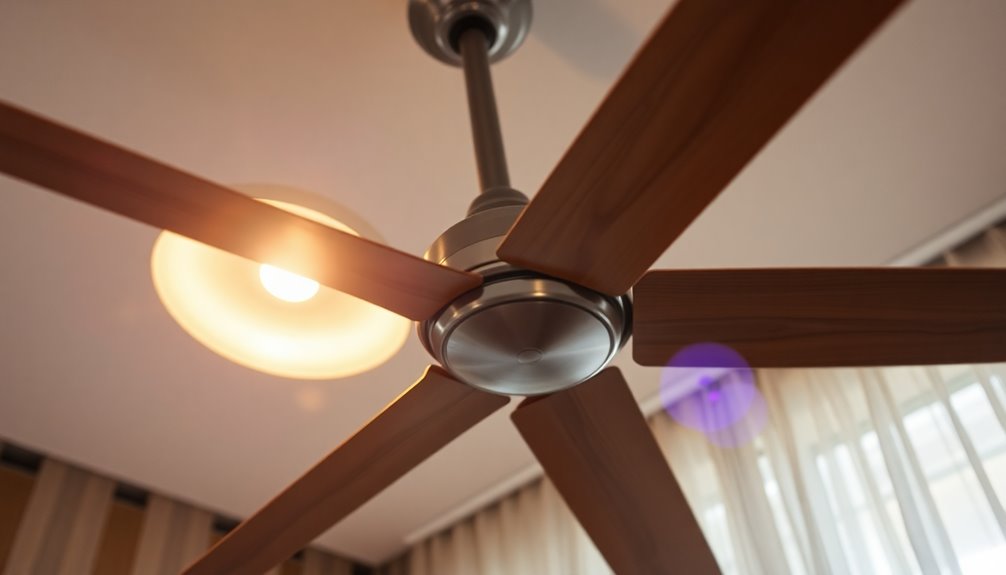Ceiling height impacts fan performance by influencing airflow, efficiency, and motor longevity. Tall ceilings require fans with longer blades and proper placement to improve air circulation and heat dissipation. Low ceilings benefit from fans close to the ceiling to avoid obstructions, while very high ceilings may need longer downrods for effectiveness. Choosing the right fan size, blade pitch, and installation height can optimize comfort and energy use—keep going to discover more tips for your space.
Key Takeaways
- Higher ceilings require fans with longer blades and downrods to ensure optimal airflow and proper air circulation.
- Ceiling height influences heat retention, affecting how effectively fans can distribute air and maintain comfort.
- Taller ceilings can cause uneven temperature distribution if fans are not properly positioned or sized.
- Proper fan placement and blade pitch tailored to ceiling height improve efficiency and airflow performance.
- Very high ceilings may increase motor workload and noise, impacting fan longevity and overall performance.
The Impact of Ceiling Height on Air Circulation

Ceiling height plays a crucial role in how effectively air circulates in a room. Higher ceilings often require different fan choices to optimize airflow, affecting your comfort and energy efficiency. With decorative fan styles, you can enhance your room’s aesthetic while improving circulation, but choosing the right style depends on ceiling height. For taller ceilings, fans with longer blades are more effective at moving air, reducing the need for additional cooling or heating. This, in turn, boosts energy efficiency by lowering energy consumption. Additionally, in rooms with lower ceilings, selecting a fan designed for limited space helps avoid a cramped feeling and ensures better airflow. Proper fan placement can also significantly impact how well air is circulated throughout the space. Additionally, considering wall organization options can help maximize space and improve overall room comfort. Understanding how ceiling height influences fan performance helps you pick the best fan to keep your space comfortable and energy-efficient.
Optimal Fan Placement for Different Ceiling Heights

To get the most out of your ceiling fan, you need to ensure its placement based on ceiling height. If you have a low ceiling, installing the fan closer to the ceiling can prevent obstructions, while high ceilings benefit from fans mounted at an ideal height for airflow. Adjusting the fan’s height guarantees you maximize efficiency and maintain comfortable air circulation throughout the space. Additionally, using a downrod can improve fan performance by increasing airflow and enhancing overall efficiency. Choosing the right fan size and blade pitch for your ceiling height further optimizes air circulation and cooling effectiveness. Proper placement also helps in comfort and safety, ensuring the fan operates safely and effectively in your space.
Low Ceiling Placement Tips
When your ceiling is low, proper fan placement can make a significant difference in comfort and efficiency. To optimize performance, consider these tips:
- Mount the fan closer to the ceiling, ideally within 8-10 inches, to prevent obstruction and maximize airflow.
- Choose fans with downrods that suit your ceiling height, avoiding large gaps that reduce effectiveness.
- Focus on lighting design by selecting fans with integrated lighting that complements your ceiling material without cluttering the space. Additionally, selecting fans with appropriate blade pitch can improve airflow performance in low-ceiling rooms.
- Keep the fan blades at least 7 feet above the floor to ensure safety and proper air circulation.
- To enhance overall image quality and viewing comfort, consider color temperature adjustments to match your room’s lighting and reduce glare. Being aware of fan placement guidelines ensures optimal airflow and safety in rooms with low ceilings.
These adjustments help maintain efficient airflow and enhance comfort, especially in rooms with low ceilings and varied ceiling materials.
High Ceiling Fan Strategies
Proper fan placement becomes especially important as ceiling height increases, since airflow patterns and efficiency can vary considerably. For high ceilings, you’ll want to install a longer downrod to position the fan closer to the living space, ensuring effective air circulation. Choose fans with durable fan blade materials like wood or metal, which maintain stability and performance at greater heights. Pay attention to remote control compatibility; a fan with this feature allows easy adjustments without climbing ladders. Ensuring the fan blades are pitched correctly enhances airflow, regardless of distance from the ceiling. Proper placement and compatible features optimize performance, keeping the room comfortable and energy-efficient. Additionally, understanding Required Minimum Distributions (RMDs) can help plan for energy savings and compliance if the fan is part of an estate or rental property. Considering professional installation can also ensure the fan is mounted correctly for maximum efficiency. Proper fan blade pitch and alignment are crucial to maximizing airflow in spaces with high ceilings. Focus on these strategies to maximize your ceiling fan’s effectiveness in spaces with high ceilings.
Optimal Height for Efficiency
Finding the ideal height for your ceiling fan is essential to maximize airflow and energy efficiency. Proper placement ensures optimal air circulation, especially when considering ceiling insulation and ambient temperature. For different ceiling heights, follow these guidelines:
- For standard 8-foot ceilings, install the fan 8-9 feet above the floor.
- For high ceilings (10-12 feet), hang the fan so it’s about 8-9 feet above the floor, possibly using a downrod.
- For very high ceilings (over 12 feet), extend the downrod to keep the fan at an ideal height.
- Always consider ceiling insulation, as it can affect heat transfer and airflow efficiency, impacting fan performance.
- Selecting the right fan size based on ceiling height ensures optimal airflow and efficiency. Proper fan placement can also help reduce energy costs and improve comfort. Additionally, choosing the correct installation height can prevent unnecessary wear on the fan motor and blades, enhancing longevity.
How High Ceilings Influence Cooling Efficiency

Higher ceilings can markedly impact how effectively your fan cools a room. When ceilings are tall, warm air tends to rise, creating a temperature gradient that can make cooling less efficient. To counteract this, you might consider strategic placement of fans to promote better air circulation. Additionally, your choice of decorative lighting can influence heat buildup, so opting for fixtures that emit less heat helps maintain comfort. The ceiling material also plays a role; reflective or insulating surfaces can affect how heat is retained or dissipated. Understanding these factors allows you to optimize your fan’s performance, ensuring cooler, more comfortable spaces even in rooms with high ceilings. Proper design and placement become essential to overcoming the challenges posed by lofty ceilings. Utilizing vertical storage solutions can help organize space more effectively, which is especially beneficial in rooms with high ceilings where clutter can quickly accumulate. Incorporating ventilation strategies can further improve airflow and temperature regulation in such environments. Additionally, considering thermal insulation can significantly influence how heat is retained or dissipated in rooms with high ceilings, further enhancing fan efficiency.
Challenges of Installing Fans in Very Low Ceilings

Installing fans in very low ceilings presents unique challenges because there’s limited space for proper blade clearance and airflow. This can affect ceiling acoustics, causing more noise or vibrations, and complicate lighting integration, as fixtures may need to be repositioned or replaced. To address these issues, consider:
Installing fans in low ceilings requires careful selection of quiet, low-profile models to optimize airflow and minimize noise.
- Choosing flush-mount or low-profile fans to maximize headroom.
- Ensuring blades are close enough to circulate air effectively without hitting the ceiling.
- Selecting fans with quiet motors to minimize noise interference with ceiling acoustics.
- Planning lighting integration carefully to avoid clutter and maintain aesthetic appeal.
- Being aware that security system deterrence can influence the safety and comfort of your space, especially in homes with low ceilings where added security features might be more visible. Additionally, understanding how ceiling height impacts fan performance can help you select the most suitable fan for your space. Properly sizing and installing the right fan can also prevent vibration issues that often occur in low-ceiling environments.
These adjustments help improve airflow, reduce noise, and allow seamless lighting, making low-ceiling fan installation more functional and less disruptive.
Choosing the Right Fan Size for Varying Heights

Choosing the right fan size depends on your ceiling height, ensuring the best airflow without overwhelming the space. For lower ceilings, smaller fans with shorter blades work best, while taller ceilings need larger fans to circulate air effectively. Adjusting fan dimensions to your ceiling height helps improve performance and comfort in any room.
Optimal Fan Dimensions
Selecting the right fan size is essential for guaranteeing effective airflow and comfort in spaces with different ceiling heights. To optimize performance, consider these factors:
- Match fan blade diameter to room size and ceiling height for proper air circulation.
- Choose fan blade materials like wood or metal based on durability and style preferences.
- Select ceiling fan styles that complement your decor while providing efficient airflow.
- Confirm the fan’s motor power aligns with the fan size to prevent wobbling or noise.
Adjusting for Ceiling Height
When it comes to ceiling height, one size doesn’t fit all. Selecting the right fan size depends on your ceiling’s height and the room’s purpose. For high ceilings, choose a larger fan with a longer downrod to ensure effective airflow. Proper lighting coordination is also essential—make sure your fan can accommodate lighting fixtures if needed. Additionally, consider ceiling insulation, as it affects air circulation and cooling efficiency. Use this guide to help choose:
| Ceiling Height | Recommended Fan Size | Notes |
|---|---|---|
| 8-9 feet | 52 inches or less | For standard rooms |
| 9-14 feet | 54-72 inches | Larger rooms, better airflow |
| Above 14 feet | Custom-sized fans | For very high ceilings |
Matching fan size with ceiling height enhances comfort and performance.
The Role of Fan Blades and Pitch in Performance

Fan blade design and pitch directly impact how effectively a ceiling fan moves air, influencing both comfort and energy efficiency. The blade’s shape, size, and curvature determine airflow, while the pitch angle controls how much air is displaced with each rotation. To optimize performance, consider these factors:
Optimizing fan blade design and pitch enhances airflow, energy efficiency, and overall comfort.
- Blade Material – Lightweight materials improve efficiency.
- Blade Shape – Curved blades generate more airflow.
- Pitch Angle – Steeper angles move more air but may create more noise.
- Number of Blades – Fewer blades often increase airflow and reduce drag.
Adjusting blade design and pitch allows you to tailor your fan’s performance to your ceiling height, ensuring effective air circulation without wasting energy. Properly designed blades enhance comfort and maximize fan lifespan.
Effects of Ceiling Height on Fan Motor Longevity

Ceiling height considerably influences the longevity of your fan motor by affecting how it operates over time. With higher ceilings, the motor winding may work harder to maintain airflow, leading to increased wear and tear. The strain on the motor can cause overheating or early failure if it’s not rated for such conditions. Additionally, the blade material plays a role; lightweight materials like plastic may reduce stress on the motor, while heavier metals require more power, potentially shortening motor life. Properly balancing the blades and choosing durable materials can help mitigate these issues. Regular maintenance, such as checking wiring and ensuring the motor winding remains cool, is essential. Overall, understanding how ceiling height impacts these factors helps you select and maintain a fan that lasts longer.
Tips for Enhancing Airflow in Rooms With Tall Ceilings

To improve airflow in rooms with tall ceilings, you should focus on strategic placement and the use of additional devices. Proper positioning helps circulate air effectively, reducing stagnant spots. Consider these tips:
- Position fans near lighting fixtures to maximize airflow without obstruction.
- Use ceiling fans with adjustable heights to better reach the upper air layers.
- Install oscillating fans or tower fans to supplement ceiling airflow.
- Ensure ceiling insulation is adequate to prevent hot air buildup, which hampers circulation.
These adjustments help create a balanced airflow, reducing temperature layers and improving comfort. Proper placement and supplemental devices ensure your fan performs at its best, making the most of your tall ceiling space.
Common Mistakes When Installing Fans in Different Ceiling Heights

When installing fans in rooms with varying ceiling heights, overlooking key factors can lead to poor airflow and reduced efficiency. One common mistake is ignoring the ceiling texture, which can impact the fan’s mounting and stability. Rough or textured ceilings may require specialized brackets or adjustments to guarantee proper installation. Another mistake is installing decorative fixtures or fans too close to ceiling decorations, which can hinder blade movement and airflow. You might also underestimate the importance of appropriate blade length or mounting height, especially in vaulted or high ceilings. Failing to take these details into account can cause uneven air circulation and noise issues. To avoid these mistakes, choose fans suited for your ceiling’s texture and height, ensuring optimal performance and safety.
Frequently Asked Questions
How Does Ceiling Height Affect Fan Noise Levels?
Higher ceilings generally lead to increased sound levels from fans because the noise has more space to disperse, which can make it seem louder. To improve noise mitigation, you might choose fans with quieter motors or install sound-dampening features. Keep in mind that larger ceiling heights can amplify sound, so selecting a fan designed for high ceilings helps you maintain a comfortable noise level while ensuring efficient airflow.
Are Specific Fan Types Better for High Ceilings?
You’ll want to choose fans with blade designs optimized for high ceilings, like those with longer blades or a downrod for better air circulation. Look for models that offer remote control compatibility, so you can easily adjust settings from anywhere. These features guarantee efficient airflow and convenience, making specific fan types, such as large, downrod-mounted fans, ideal for high ceilings, improving comfort and performance.
Can Ceiling Height Impact Fan Energy Consumption?
When it comes to ceiling height, don’t think it’s a one-size-fits-all situation. Yes, ceiling height can impact fan energy consumption, as taller ceilings may require more power for the fan to circulate air effectively. This can affect fan efficiency, making it work harder and use more energy. To save energy, choose fans designed for your ceiling height, and you’ll keep things running smoothly without breaking the bank.
What Safety Considerations Exist for High Ceiling Fans?
You should always follow safety standards and installation guidelines when installing high ceiling fans. Make certain the fan is securely mounted to support the weight and prevent wobbling. Keep the blades a safe distance from walls and ceilings to avoid accidents. Regularly inspect the fan for loose parts or wear. Using proper safety precautions helps prevent injuries and ensures safe, efficient operation in spaces with high ceilings.
How Does Ceiling Height Influence Fan Maintenance Requirements?
You’ll find that ceiling height impacts fan maintenance because taller ceilings often mean harder access for cleaning and repairs. Fan blade design matters—larger or more complex blades may require more careful cleaning. Additionally, ceiling insulation can gather dust or debris, affecting performance. With higher ceilings, you’ll need specialized tools or professional help to keep your fan running smoothly and ensure ongoing safety and efficiency.
Conclusion
Just like Daedalus crafted wings to navigate the skies, selecting the right fan for your ceiling height helps you master air circulation. Whether you have low or soaring ceilings, understanding the nuances ensures ideal comfort and efficiency. Avoid the pitfalls of poor installation and let your fan work like Icarus’ wings—precise, reliable, and soaring to meet your cooling needs. With the right choices, you’ll keep your space breezy and balanced, no matter how high the heavens.









